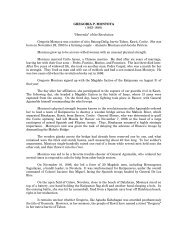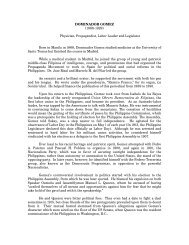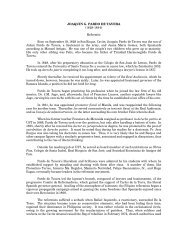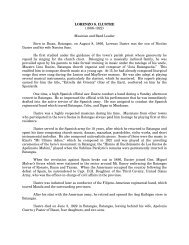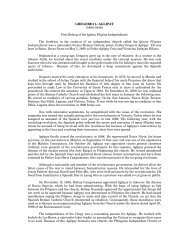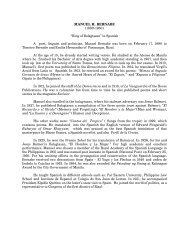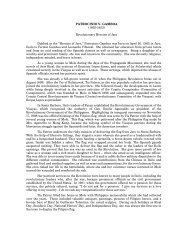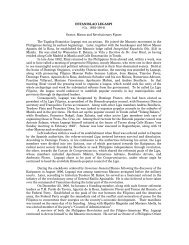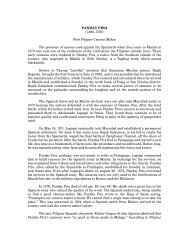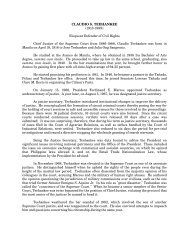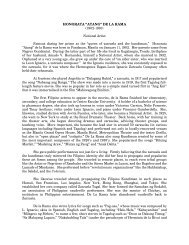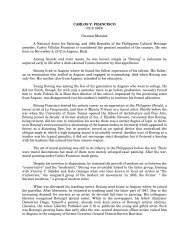MANUEL S. TINIO - National Historical Commission of the Philippines
MANUEL S. TINIO - National Historical Commission of the Philippines
MANUEL S. TINIO - National Historical Commission of the Philippines
You also want an ePaper? Increase the reach of your titles
YUMPU automatically turns print PDFs into web optimized ePapers that Google loves.
<strong>MANUEL</strong> S. <strong>TINIO</strong><br />
(1877 – 1924)<br />
Youngest General in <strong>the</strong> Revolutionary Army<br />
Manuel Tinio was born in Aliaga, Nueva Ecija on June 17, 1877. His parents were Mariano<br />
Tinio y Santiago and Silveria Bundok. He was educated in private schools and <strong>the</strong>n at <strong>the</strong> Colegio<br />
de San Jaun de Letran in Manila where he studied his segunda ensenanza from 1891 to 1896.<br />
In April 1896, he joined <strong>the</strong> Katipunan. When General Mariano Llanera rallied <strong>the</strong> people<br />
<strong>of</strong> Nueva Ecija to revolt, he ga<strong>the</strong>red forces in his hometown and carried on <strong>the</strong> fight against <strong>the</strong><br />
Spaniards in <strong>the</strong> forests <strong>of</strong> <strong>the</strong> province. In an encounter on January 14, 1897, he inflicted heavy<br />
casualties on <strong>the</strong> enemies.<br />
On June 6, 1897, in recognition <strong>of</strong> his services, he was conferred by <strong>the</strong> Assembly <strong>of</strong> Puray<br />
<strong>the</strong> rank <strong>of</strong> colonel and <strong>the</strong> command <strong>of</strong> a brigade. He took part in <strong>the</strong> attack <strong>of</strong> San Rafael,<br />
Bulacan that was led by General Mamerto Natividad. To rescue his hometown Aliaga, he fought<br />
against a formidable army <strong>of</strong> 8,000 men mobilized by General Primo de Rivera. In this encounter,<br />
<strong>the</strong> Spaniards suffered heavy casualties and he put to fight <strong>the</strong> column <strong>of</strong> Spanish General Nunez<br />
who was seriously wounded . He and his men held <strong>the</strong> town for three days but fell back when<br />
pressed by General Ricardo Monet.<br />
He won a number <strong>of</strong> skirmishes against <strong>the</strong> Spanish cazadores in several o<strong>the</strong>r towns <strong>of</strong><br />
Nueva Ecija. He assisted in <strong>the</strong> taking <strong>of</strong> an important Spanish convoy on its way from Kabiaw to<br />
San Isidro. General Natividad was killed in this encounter.<br />
When <strong>the</strong> “Gobierno Departamental de las Siete Provincias en el Centro de Luzon” was<br />
established, Tinio was one <strong>of</strong> <strong>the</strong> Brigadier Generals named. The departamental government<br />
however, was abolished during <strong>the</strong> latter part <strong>of</strong> November 1897.<br />
By virtue <strong>of</strong> <strong>the</strong> Truce <strong>of</strong> Biak-na-Bato, he and o<strong>the</strong>r revolutionary leaders went to<br />
Hongkong as exiles.<br />
When he returned to <strong>the</strong> <strong>Philippines</strong>, he was made second in command <strong>of</strong> <strong>the</strong> first zone <strong>of</strong><br />
Nueva Ecija on July 7, 1898. Then he was appointed to lead an expedition to Nor<strong>the</strong>rn Luzon.<br />
With 300 Mauser guns captured in Hagonoy, <strong>the</strong> young colonel proceeded to conquer within 15<br />
days <strong>the</strong> provinces <strong>of</strong> La Union, Ilocos Norte, Ilocos Sur, Abra, Benguet, Tiagan, Amburayan,<br />
Lepanto, Bontok and four towns <strong>of</strong> Cagayan. He met resistance only in San Fernando de la Union<br />
and in Aparri. In <strong>the</strong>se provinces, Tinio captured 3,000 guns.<br />
On August 14, 1898, he occupied Vigan and by <strong>the</strong> 17 th , <strong>the</strong> o<strong>the</strong>r principal towns <strong>of</strong> Ilocos<br />
namely Bangar, Tagudin, and Laoag. Upon his arrival, <strong>the</strong> friars including <strong>the</strong> Bishop <strong>of</strong> Nueva<br />
Segovia. Msgr. Jose Hevia Campomanes, escaped by boat to Aparri. He used <strong>the</strong> palacio <strong>of</strong> Vigan,<br />
<strong>the</strong> former residence <strong>of</strong> <strong>the</strong> Spanish governor as his headquarters.<br />
In <strong>the</strong> next three months, he consolidated under his command <strong>the</strong> territory extending from<br />
<strong>the</strong> barrio <strong>of</strong> Rabong at <strong>the</strong> sou<strong>the</strong>rn boundary <strong>of</strong> La Union to Cape Bojeador, <strong>the</strong> nor<strong>the</strong>rnmost<br />
point <strong>of</strong> Ilocos Norte. Desirous <strong>of</strong> establishing complete peace in Ilocos Sur to enable <strong>the</strong> citizens<br />
to take up <strong>the</strong>ir customary occupation and to encourage commerce to go on as before, he issued on<br />
August 178, 1898 one <strong>of</strong> his first decrees for <strong>the</strong> Ilocos. It consisted <strong>of</strong> six articles and called for <strong>the</strong><br />
“considerate treatment <strong>of</strong> <strong>the</strong> Spanish peninsulars and insulars and <strong>the</strong> confiscation <strong>of</strong> <strong>the</strong>ir<br />
general property; sending to his headquarters <strong>the</strong> deserters from <strong>the</strong> Spanish army who wanted to<br />
join <strong>the</strong> Filipino forces; prohibition <strong>of</strong> <strong>the</strong> use <strong>of</strong> firearms to all citizens; continuance <strong>of</strong> existing<br />
municipal system in towns where elections where not yet held; rigorous punishment for all who<br />
committed abuses and; orders for strict compliance <strong>of</strong> all <strong>the</strong>se provision.”
On <strong>the</strong> same day, he appointed Francisco Rivero Paz de Leon as temporary president <strong>of</strong><br />
Ilocos Sur and <strong>the</strong> following day, he ordered <strong>the</strong> reinstallation <strong>of</strong> destroyed telegraphic lines. He<br />
gave more orders such as <strong>the</strong> inventory <strong>of</strong> <strong>the</strong> property left by <strong>the</strong> Spaniards, <strong>the</strong> establishment <strong>of</strong> a<br />
new government in <strong>the</strong> districts <strong>of</strong> Lepanto and Tiagan and <strong>the</strong> formation <strong>of</strong> rancherias within<br />
Narvacan up to Tagudin into towns.<br />
As his battalions were still incomplete by November 1898, he made known his need for<br />
volunteers between <strong>the</strong> ages <strong>of</strong> 17 to 30 who wanted to serve <strong>the</strong> revolutionary army permanently.<br />
On November 11, 1898, he was promoted <strong>the</strong> rank <strong>of</strong> General <strong>of</strong> Division. He was only 21<br />
years old.<br />
When <strong>the</strong> Philippine – American War broke out on February 4, 1899, <strong>the</strong> young general<br />
<strong>of</strong>fered his services to General Antonio Luna, chief <strong>of</strong> operations north <strong>of</strong> Manila. But his request<br />
was not granted. Undaunted, he and his men prepared for action. In cooperation with Lt. Col.<br />
Blas Villamor, he established trenches and fortifications in strategic points in Ilocos as a means <strong>of</strong><br />
defense. He also distributed his 2,000 men along <strong>the</strong> more than 270 kilometer coast from<br />
Tagudin, Ilocos Sur to Bangui, Ilocos Norte. These were accomplished before mid-March 1899.<br />
His chance to fight <strong>the</strong> Americans came in connection with <strong>the</strong> retreat <strong>of</strong> General Emilio<br />
Aguinaldo and his men to <strong>the</strong> north.<br />
His soldiers totaling 285 formed <strong>the</strong> rear guard <strong>of</strong> Aguinaldo’s column in <strong>the</strong> march to<br />
Manaoag, Pangasinan, escorting <strong>the</strong> president’s mo<strong>the</strong>r and son, toge<strong>the</strong>r with <strong>the</strong> wounded and<br />
sick soldiers. In <strong>the</strong> afternoon <strong>of</strong> November 14, on <strong>the</strong> way to Pozorrubio from Manaoag he and his<br />
men had a surprise encounter with <strong>the</strong> enemies coming from Nueva Ecija led by Major Swigert.<br />
The Filipinos drove <strong>the</strong>m towards Binalonan, enabling Aguinaldo to continue <strong>the</strong> flight northward.<br />
He also intercepted in San Jacinto <strong>the</strong> advance <strong>of</strong> Lloyd Wheaton who came from his military base<br />
in San Fabian.<br />
When <strong>the</strong> Americans disembarked in Pandan, Ilocos Sur, he fortified himself in <strong>the</strong><br />
mountain <strong>of</strong> Tangadan, sou<strong>the</strong>ast <strong>of</strong> Abra, and established his headquarters in <strong>the</strong> town <strong>of</strong> San<br />
Quintin, about two miles from Tangadan.<br />
On December 3, 1899, Tinio ordered his men to raid Vigan which was occupied by Colonel<br />
Parker. The raid lasted <strong>the</strong> whole night but was not successful. They withdrew and <strong>the</strong> next day,<br />
<strong>the</strong> small force defending Tangadan was attacked by <strong>the</strong> enemies. After a day and night <strong>of</strong> fighting,<br />
his troops abandoned Tangadan.<br />
On December 3, 1899, Tinio ordered his men to raid Vigan which was occupied by Colonel<br />
Parker. The raid lasted <strong>the</strong> whole night but was not successful. They withdrew and <strong>the</strong> next day,<br />
<strong>the</strong> small force defending Tangadan was attacked by <strong>the</strong> enemies. After a day and night <strong>of</strong> fighting,<br />
his troops abandoned Tangadan.<br />
With its capture by <strong>the</strong> Americans, Tinio changed his military strategy in dealing with <strong>the</strong><br />
enemies. He divided and organized his brigade into guerilla units and posted <strong>the</strong>m along <strong>the</strong> road<br />
and strategic locations from <strong>the</strong> rancheria <strong>of</strong> Danglas to Ilocos Norte, with instructions to ambush<br />
<strong>the</strong> passing enemy through Tambang. By March 22, 1900, each town under Tinio’s jurisdiction<br />
had its own columnas volantes. To facilitate <strong>the</strong> movement and maneuver <strong>of</strong> his troops, Tinio<br />
ordered <strong>the</strong> local presidents to furnish him with detailed maps and plans <strong>of</strong> <strong>the</strong> towns.<br />
Appraising his mission in <strong>the</strong> Ilocos region, <strong>the</strong> young Tagalog general wrote:
“I have endeavored to propagate and implant here <strong>the</strong> society <strong>of</strong> <strong>the</strong> Katipunan which has<br />
produced surprising results. I have prepared <strong>the</strong> spirit <strong>of</strong> <strong>the</strong> inhabitants so that aside from<br />
inculcating in <strong>the</strong>m <strong>the</strong> fecund germ <strong>of</strong> <strong>the</strong> high ideals <strong>of</strong> liberty, <strong>the</strong>y have come to show<br />
implacable hatred towards <strong>the</strong> invader, passion which some citizens, armed with only bolos have<br />
manifested to <strong>the</strong> Americans who dared to travel from <strong>the</strong>ir detachment.”<br />
The local citizenry proved helpful to <strong>the</strong> troops by supplying <strong>the</strong>m with abundant<br />
ammunitions, and, acting as polistas, <strong>the</strong>y served as vigilants in spying for <strong>the</strong> approaching<br />
enemies. Tinio, a Tagalog, was thus successful in welding toge<strong>the</strong>r <strong>the</strong> cooperative spirit <strong>of</strong> <strong>the</strong><br />
Ilocanos for patriotic cause. To achieve this goal, Tinio used persuasion and threat. For instance,<br />
he implored <strong>the</strong> local president <strong>of</strong> Bangui to inculcate <strong>the</strong> idea <strong>of</strong> patriotism to <strong>the</strong> principales and<br />
<strong>the</strong> barrio cabezas. He also circularized <strong>the</strong> crimes punishable by deaths and severe penalties. To<br />
those who kept who kept friendly relations with <strong>the</strong> Americans, he sent letters warning <strong>the</strong>m to<br />
repent or else be punished rigorously. Even Pedro Legazpi, a town presidente and a personal<br />
friend <strong>of</strong> Tinio received such a letter for showing damnable conduct. Tinio also kept an eye on his<br />
soldiers whom he ordered, under severe punishment, to refrain from opening communications<br />
with <strong>the</strong> enemies.<br />
By mid June 1900,Tinio exerted to establish arsenals in various points <strong>of</strong> his jurisdiction.<br />
To do this job in La Union, he assigned Joaquin Alejandrino whom he appointed as chief <strong>of</strong> <strong>the</strong><br />
province on June 26, 1900.<br />
General Tinio, believing that “firmness is one <strong>of</strong> <strong>the</strong> conditions necessary to obtain our<br />
coveted independence”, carried on <strong>the</strong> fight. He would never surrender, as American deserter<br />
John Allane attested. He waited for <strong>the</strong> action <strong>of</strong> <strong>the</strong> U.S. Congress regarding <strong>the</strong> Philippine<br />
situation or until a new president was elected. When Allane surrendered on April 14, 1901, he<br />
informed <strong>the</strong> Americans that Tinio had 70 men and about 40 <strong>of</strong> <strong>the</strong>m had U.S. arms.<br />
On May 1, 1901, obeying Aguinaldo’s appeal, Tinio gave up with his 36 <strong>of</strong>ficers to General<br />
J. Franklin Bell. General Arthur MacArthur put importance to his surrender by releasing 1,000<br />
Filipino soldiers held prisoner.<br />
After more than four years <strong>of</strong> fighting, Tinio retired to Licab and engaged in farming. He<br />
acted as governor <strong>of</strong> Nueva Ecija since <strong>the</strong> election <strong>of</strong> Isauro Gabaldon to <strong>the</strong> first Philippine<br />
Assembly in 1907 and was elected to <strong>the</strong> same position on November 5 <strong>of</strong> <strong>the</strong> same year. He<br />
resigned from <strong>the</strong> governorship and on July 1, 1909, he was appointed by Governor General James<br />
F. Smith as <strong>the</strong> first director <strong>of</strong> <strong>the</strong> Bureau <strong>of</strong> Labor. On October 17, 1913, he was appointed<br />
Director <strong>of</strong> Lands, <strong>the</strong> first Filipino to occupy <strong>the</strong> position which he held up to 1914.<br />
As director <strong>of</strong> Bureau <strong>of</strong> Labor, Tinio showed his ability as administrator and as excellent<br />
conciliator. Governor-General William Cameron Forbes commended his work in <strong>the</strong> improvement<br />
<strong>of</strong> <strong>the</strong> bad situation caused by strikes and “in <strong>the</strong> enlightenment <strong>of</strong> <strong>the</strong> people in regard to strikes<br />
and <strong>the</strong>ir effects.”<br />
After leaving <strong>the</strong> government service, Tinio toured Europe. Upon his return, he entered<br />
politics and headed <strong>the</strong> <strong>National</strong>ista Party in Nueva Ecija. He died on February 22, 1944.<br />
References:<br />
Alvarez, Santiago U. The Katipunan and <strong>the</strong> Revolution: Memoirs <strong>of</strong> a General. Quezon City:<br />
Ateneo de Manila University Press, 1992.<br />
Malay, Armando U. Memoirs <strong>of</strong> General Artemio Ricarte. Manila: <strong>National</strong> <strong>Historical</strong><br />
<strong>Commission</strong>, 1963.
Ochoso, Orlino. Tinio Brigade: An anti-American resistance in <strong>the</strong> Ilocos provinces 1899 – 1901.<br />
Quezon City: New Day Publishers, 1989.



